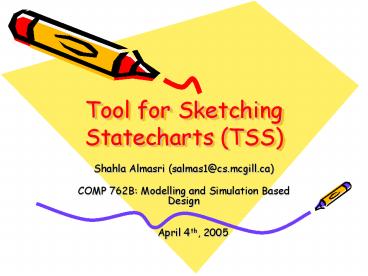Tool for Sketching Statecharts TSS - PowerPoint PPT Presentation
Title:
Tool for Sketching Statecharts TSS
Description:
Can be run on any machine that has JDK 1.4 or higher. It can be run using a stylus or a mouse. ... Interface Software and Technology, CHI Letters , 2(2), p. 63 ... – PowerPoint PPT presentation
Number of Views:39
Avg rating:3.0/5.0
Title: Tool for Sketching Statecharts TSS
1
Tool for Sketching Statecharts (TSS)
- Shahla Almasri (salmas1_at_cs.mcgill.ca)
- COMP 762B Modelling and Simulation Based
Design - April 4th, 2005
2
Agenda
- Implementation Details
- SATIN
- Introduction to Statecharts
- TSS Syntax
- Demo
- Conclusion
- Future work
3
Implementation Details
- TSS is written in Java using JDK 1.5 and SATIN
2.31. - Can be run on any machine that has JDK 1.4 or
higher. - It can be run using a stylus or a mouse.
1. Refer to reference 2 for detailed
information.
4
Agenda
- Implementation Details
- SATIN
- Introduction to Statecharts
- TSS Syntax
- Demo
- Conclusion
- Future work
5
SATIN
- Sketch and Transformational Infrastructure
(http//guir.berkeley.edu/projects/satin/) - An open-source toolkit for developing informal
ink-based applications. - It only supports 2D applications.
6
SATIN (cont.)
- Built using JDK 1.3.
- SATIN is a layer on top of Swing.
This figure is taken from reference 2.
7
SATIN (cont.)
- SATIN comes with Quill, which is a tool for
designing gestures for pen-based applications. - SATIN framework comes with Rubines1 recognition
algorithm, but other recognition algorithm can
easily be plugged in.
1. Dean Rubine. Specifying Gestures by
Examples, Computer Graphics. ACM SIGGRAPH91
Conference Proceedings. 25(3) pp.329-337, July,
1991.
8
Agenda
- Implementation Details
- SATIN
- Introduction to Statecharts
- TSS Syntax
- Demo
- Conclusion
- Future work
9
Introduction to Statecharts
- An extension of finite state automata.
- Invented by David Harel in the late 1980s.
- It was adopted by UML for describing reactive
behavior.
10
Agenda
- Implementation Details
- SATIN
- Introduction to Statecharts
- TSS Syntax
- Demo
- Conclusion
- Future work
11
TSS Syntax
- Statecharts notations
- Supported characters
- Supported commands
- How gestures are interpreted
- Statechart diagram validation
12
Statecharts Notations
Recognized as state, therefore transformed to
Recognized as default state, therefore
transformed to
13
Statecharts Notations (cont)
14
Statecharts Notations (cont.)
Recognized as transition, therefore transformed to
15
Supported Characters
16
Supported Characters (cont.)
17
Supported Characters (cont.)
18
Supported Characters (cont.)
19
Supported Characters (cont.)
20
Supported Commands
21
Supported Commands (cont.)
22
Supported Commands (cont.)
23
Supported Commands (cont.)
24
Supported Commands (cont.)
25
How interpretation works
26
Statechart Diagram Validation
- A valid statechart diagram has to have a default
state.
27
Agenda
- Implementation Details
- SATIN
- Introduction to Statecharts
- TSS Syntax
- Demo
- Conclusion
- Future work
28
Demo
29
Conclusion
- SATIN saves time by providing a concrete
framework for pen-based applications. - It provides many of the common features in
pen-based applications
30
Conclusion
- It is hard to design gestures that are easy to
learn by humans and easy to recognize by
computers1. - Studies found that users who are used to using
PDAs are better at designing good gestures1.
1. Refer to reference 3.
31
Remaining work
- Fix some known bugs
- Cannot edit transitions labels.
- When opening a saved file, transitions labels do
not show up. - Non-recognized objects are not saved.
- Cannot select labels.
- Moving, resizing, and deleting states and
transitions dont always work. - Write the report.
32
Future work
- Support composite and orthogonal states.
- Keep transitions the way they were drawn.
33
References
- 1 David Harel, Statecharts a visual formalism
for complex system, Science Computer Program,
Vol 8, pp 231-274, 1987. - 2 Jason I. Hong and James A. Landay, "SATIN A
Toolkit for Informal Ink-based Applications." In
UIST 2000, ACM Symposium on User Interface
Software and Technology, CHI Letters , 2(2), p.
63-72.
34
References (cont.)
- 3 Allan Christian Long, Jr., James A. Landay,
and Lawrence A. Rowe, "Implications for a Gesture
Design Tool." In Proceedings of Human Factors in
Computer Systems CHI 99, Pittsburgh, PA, May
15-20, 1999, pp. 40-47.































